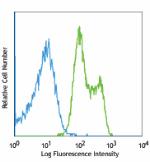- Clone
- HMHV-1B18 (See other available formats)
- Regulatory Status
- RUO
- Other Names
- Herpes virus entry mediator, TR2, tumor necrosis factor receptor like 2, TNFRSF14, HVEM
- Isotype
- Armenian Hamster IgG
- Barcode Sequence
- GATCCGTGTTGCCTA
| Cat # | Size | Price | Quantity Check Availability | ||
|---|---|---|---|---|---|
| 136307 | 10 µg | $369.00 | |||
Herpes Virus Entry Mediator (HVEM, TR2) is a type I transmembrane protein of TNF-receptor superfamily. This receptor was identified as a cellular mediator of herpes simplex virus (HAS) entry. Binding of HSV viral envelope glycoprotein D to this receptor has been shown to be part of the viral entry mechanism. It is expressed on most cell types, including T cells, B cells, monocytes, neutrophils, and dendritic cells. It is also found in brain, heart, kidney, liver, and other organs. The ligands of HVEM are LIGHT, BTLA, LTα, and CD160. HVEM activates NF-kB through the TNF-related cytokine LIGHT to serve as a costimulatory pathway during T cell activation. HVEM also functions as a ligand for the Ig superfamily members B and T lymphocyte attenuator (BTLA) and CD160 to deliver a coinhibitory signal and limit inflammatory responses initiated by T cells. HVEM plays an important role in regulating lymphocyte activation and homeostasis in immune responses.
Product Details
- Verified Reactivity
- Mouse
- Antibody Type
- Monoclonal
- Host Species
- Armenian Hamster
- Immunogen
- Mouse HVEM-hIgG1Fc fusion protein
- Formulation
- Phosphate-buffered solution, pH 7.2, containing 0.09% sodium azide and EDTA
- Preparation
- The antibody was purified by chromatography and conjugated with TotalSeq™-A oligomer under optimal conditions.
- Concentration
- 0.5 mg/ml
- Storage & Handling
- The antibody solution should be stored undiluted between 2°C and 8°C. Do not freeze.
- Application
-
PG - Quality tested
- Recommended Usage
-
Each lot of this antibody is quality control tested by immunofluorescent staining with flow cytometric analysis and the oligomer sequence is confirmed by sequencing. TotalSeq™-A antibodies are compatible with 10x Genomics Single Cell Gene Expression Solutions.
To maximize performance, it is strongly recommended that the reagent be titrated for each application, and that you centrifuge the antibody dilution before adding to the cells at 14,000xg at 2 - 8°C for 10 minutes. Carefully pipette out the liquid avoiding the bottom of the tube and add to the cell suspension. For Proteogenomics analysis, the suggested starting amount of this reagent for titration is ≤ 1.0 µg per million cells in 100 µL volume. Refer to the corresponding TotalSeq™ protocol for specific staining instructions.
Buyer is solely responsible for determining whether Buyer has all intellectual property rights that are necessary for Buyer's intended uses of the BioLegend TotalSeq™ products. For example, for any technology platform Buyer uses with TotalSeq™, it is Buyer's sole responsibility to determine whether it has all necessary third party intellectual property rights to use that platform and TotalSeq™ with that platform. - Additional Product Notes
-
TotalSeq™ reagents are designed to profile protein levels at a single cell level following an optimized protocol similar to the CITE-seq workflow. A compatible single cell device (e.g. 10x Genomics Chromium System and Reagents) and sequencer (e.g. Illumina analyzers) are required. Please contact technical support for more information, or visit biolegend.com/totalseq.
The barcode flanking sequences are CCTTGGCACCCGAGAATTCCA (PCR handle), and BAAAAAAAAAAAAAAAAAAAAAAAAAAAAAA*A*A (capture sequence). B represents either C, G, or T, and * indicates a phosphorothioated bond, to prevent nuclease degradation.
View more applications data for this product in our Scientific Poster Library. - Product Citations
-
- RRID
-
AB_2810403 (BioLegend Cat. No. 136307)
Antigen Details
- Structure
- A type I transmembrane protein of TNF-receptor superfamily.
- Distribution
-
It is expressed on most cell types, including T cells, B cells, monocytes, neutrophils, and dendritic cells. It is also found in brain, heart, kidney, liver, and other organs.
- Function
- Play an important role in regulating lymphocyte activation and homeostasis in immune responses.
- Ligand/Receptor
- LIGHT, BTLA, LTα, CD160
- Cell Type
- B cells, Dendritic cells, Neutrophils
- Biology Area
- Cell Adhesion, Cell Biology, Immunology, Signal Transduction
- Molecular Family
- Adhesion Molecules, CD Molecules
- Antigen References
-
1. Fan Z, et al. 2006. Blood 107(4):1342
2. Granger SW, et al. 2008. Stem Cells. 27:653
3. Kwon BS, et al. 1997. J. Biol. Chem. 272:13471
4. Gonzalez LC, et al. 2005. Proc. Nat. Acad. Sci. U. S. A. 102:1116
5. Montgomery RI, et al. 1996. Cell. 87:427
6. Cheung TC, et al. 2009. Proc. Nat. Acad. Sci. U. S. A. 106 (15):6244
7. Cai G, et al. 2009. Immunol. Rev. 229(1):244 - Gene ID
- 230979 View all products for this Gene ID
- UniProt
- View information about CD270 on UniProt.org
Other Formats
View All CD270 Reagents Request Custom Conjugation| Description | Clone | Applications |
|---|---|---|
| Purified anti-mouse CD270 (HVEM) | HMHV-1B18 | FC |
| PE anti-mouse CD270 (HVEM) | HMHV-1B18 | FC |
| APC anti-mouse CD270 (HVEM) | HMHV-1B18 | FC |
| TotalSeq™-A0885 anti-mouse CD270 (HVEM) | HMHV-1B18 | PG |
| TotalSeq™-C0885 anti-mouse CD270 (HVEM) | HMHV-1B18 | PG |
Compare Data Across All Formats
This data display is provided for general comparisons between formats.
Your actual data may vary due to variations in samples, target cells, instruments and their settings, staining conditions, and other factors.
If you need assistance with selecting the best format contact our expert technical support team.
-
Purified anti-mouse CD270 (HVEM)

C57BL/6 splenocytes stained with HMHV-1B18 PE -
PE anti-mouse CD270 (HVEM)

C57BL/6 splenocytes stained with HMHV-1B18 PE -
APC anti-mouse CD270 (HVEM)

C57BL/6 splenocytes stained with HMHV-1B18 APC -
TotalSeq™-A0885 anti-mouse CD270 (HVEM)
-
TotalSeq™-C0885 anti-mouse CD270 (HVEM)
